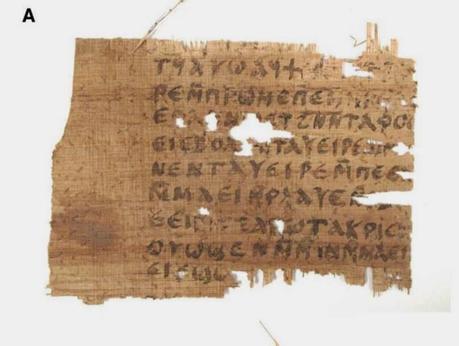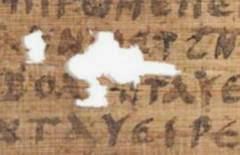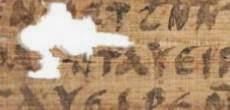Possible further proof of forgeryA reading of the text of the Lycopolitan fragment of the Gospel of John, with remarks about suspicious phenomena in the areas of the lacunae and a note about the supposed Gospel of Jesus’ WifeJoost L. Hagen
The post is also available as a PDF. It's all worth reading, but there is one particular piece that is worth highlighting: a large hole in the fragment appears to have been present before the scribe wrote on the papyrus. He writes the letters around the lacuna, and his ⲛ (N), in particular, is almost comically small. In other words, the papyrus was already damaged before the scribe wrote on it, a scenario that only makes sense if we are dealing with a modern forger writing on an ancient scrap of already damaged papyrus.
Let's take a closer look. Here is a picture of the recto of the fragment, extracted from the Infrared Microspectroscopy report on the Harvard Divinity School website:

Lycopolitan John, Recto, extracted from the Infrared Microspectroscopy Report
The lacuna in question is in the upper middle part of the fragment. It's the largest hole you are looking at, and it spans lines 4 and 5 (bear in mind that 1 is eligible). Hagen writes [font]- [ⲛ]ⲉ̣ⲛ̣ⲧⲁⲩ, for us, was the final "smoking gun" of this fragment: I had already noted that there is no place for ⲛⲉ in the lacuna, and that the surviving trace does not present a convincing ⲉ, when Frederic Krueger drew our attention to the fact that ⲛⲧⲁⲩ clearly seems to have been written under and next to an already existing gap in the papyrus: notice how ⲛ is only half the height of the other letters of the line, how ⲧ is already able to get somewhat bigger, and how ⲩ is finally able to stretch to full normal height. According to me, if the damage had occurred after the writing of the text, at the very least the ⲛ should look different.Well done to Frederic Krueger for this key observation. He's quite right -- ⲛ̣ⲧⲁⲩ (NTAU) is clearly written with the hole already present in the papyrus. Let's take a closer look:

Detail of lacuna in Lycopolitan John
The ⲛ (N), is very small and is written right underneath the hole; the ⲧ (T) next to it is larger, as proportions of the hole allow, and then the ⲁ (A) is larger and the ⲩ (U) larger still.
Harvard Divinity School have not yet released high definition images of this fragment and we are reliant on the one image that appears on the online PDF of the Infrared Microspectroscopy report, and this is the best that I can do with them; when we magnify any further, they simply degrade. Nevertheless, it's worth taking a second look at the detail of what we have just so that we can be sure we are not seeing things:

Another detail of lacuna in Lycopolitan John
At this point, I can't help thinking of Leo Depuydt's remarks in his article in the latest Harvard Theological Review with respect to the Jesus Wife Fragment. Like that fragment, it seems clear that this is a forgery, "and not a very good one at that" (HTR 107:2 [2014]: 172–89 [172]). Of course we await HDS's release of better pictures of this fragment, but on the evidence of what we have I am strongly inclined to agree with Krueger's and Hagen's judgment on Suciu's blog.
It's in the Forgery 101 textbook that you do not write your text around existing lacunas in the papyrus fragment that you are using.
To borrow a comment from Hugo Lundhaug, we now have enough smoking guns for an entire platoon.
